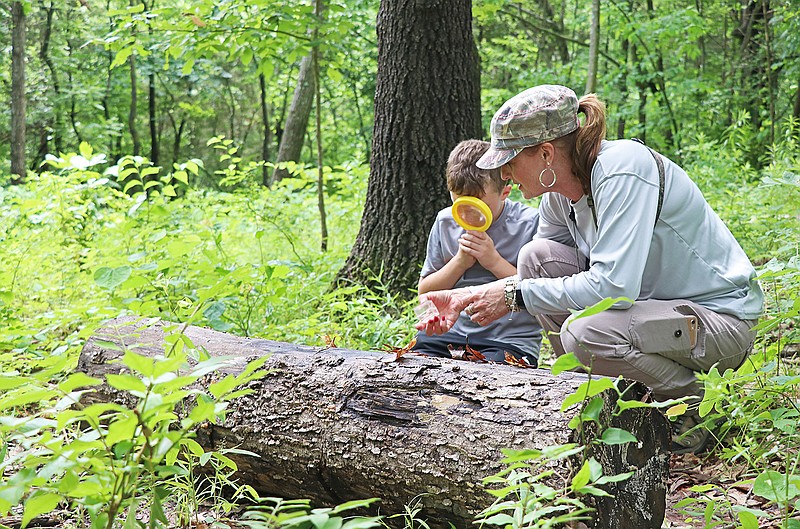Jaime Leahy shone his headlamp among the lily pads, creeping quietly through the murky water.
Whip-fast, he plunged in his hand and pulled out a writhing creature.
"I've got a water snake," the teen proclaimed.
Rather than reacting with fear or alarm, the other participants in Friday night's survey of ponds and wetlands around Runge Nature Center clustered in close. One young girl even reached out a finger to pet the scaly creature.
"This one's actually really nice for a water snake," Leahy said, pointing out how it hadn't bitten him. "Smell that musk? It's my new cologne."
The 2019 BioBlitz at Runge Nature Center was full of those moments of discovery and excitement. During a BioBlitz, naturalists, volunteers and members of the public work to identify as many species of organism as possible within a 24-hour period. If it's alive, it gets logged - anything from fungi to plants, insects to mammals.
A BioBlitz helps capture a cross-section of the biodiversity (the vast variety of living things) at a single location. It also stokes the public interest in nature. The BioBlitz on Friday and Saturday at Runge was the nature center's first.
The event drew big crowds, and participants ran the gamut in ages and experience level.
"I was expecting maybe 10 or 15 people, but I think we had closer to 30 at one point," said Sam Stewart, the naturalist leading Friday night's amphibian walk. "Wet and slimy things are popular, and going out at night is really intriguing to people."
The frogs and salamanders turned up during the amphibian walk were certainly a hit among the young participants.
"I got another frog, a big one," Kaitlyn Rezac exclaimed. "I've been trying to do it for two hours."
At age 8, Rezac is already a veteran frog catcher.
"I have tadpoles at my pond right now," she said. "I like catching them and hearing them sing. When you're catching a little frog, you have to be quick like lightning."
For those less enthusiastic about wet and slimy creatures, other opportunities included a firefly watch, small-mammal trapping, bird watching, plant identification, insect surveys and more.
Opportunities to learn from experts abounded at each station.
Jeanette Bradley, a bat biologist, expertly held a big brown bat near a mist net stretched across the trail. She and several other volunteers stayed out until 11 p.m. Friday catching, weighing and marking bats.
"The big brown bat is the largest in the state," she explained.
She said the species is adapted to urban areas and returns to the same place each year to roost, whether that be a dead tree or a church steeple.
On Friday afternoon, natural history biologist Reese Worthington led a survey of prairie insects. For each new bug carried to him tangled in a net or clutched in a hand, he had a fact at the ready. He was especially pleased to see a milkweed beetle - a large, red beetle with black spots that prefers munching on milkweed.
"I'm a beetle guy, for sure," he said.
Children holding nets plunged boldly into the tall grass, returning with butterflies, beetles and even the occasional wasp.
"I'm good at catching big bees," 6-year-old Graham Roth bragged. "They keep landing on my shirt."
Aside from the beetles, the interacting with the children were Worthington's favorite part of the event.
"I love getting kids involved in nature," he said. "Everything's at eye level for them, and they haven't yet been told that insects are bad. They come in with this wholesomeness and genuine interest."
He hopes some of the children participating in BioBlitz might become part of the next generation of naturalists.

